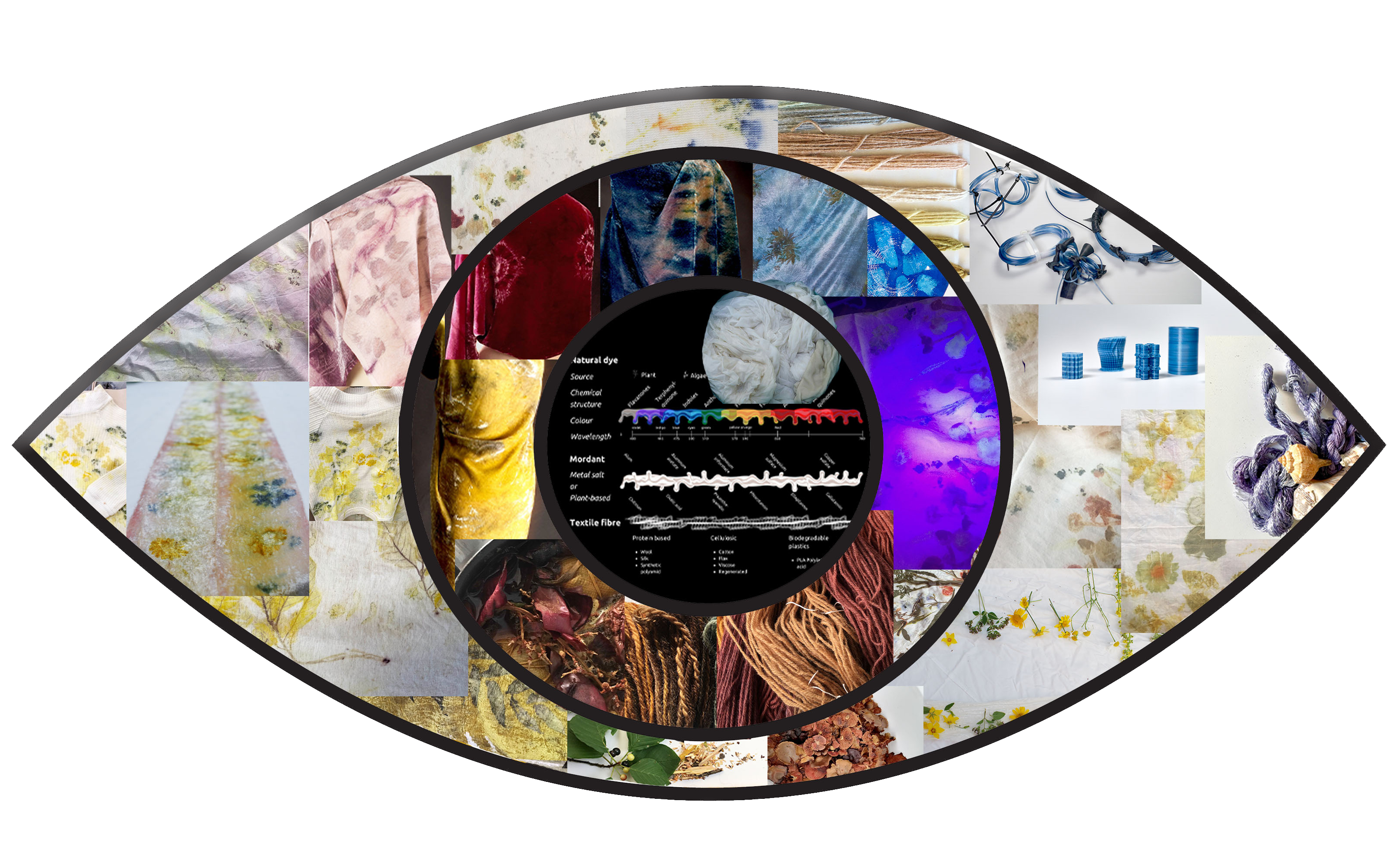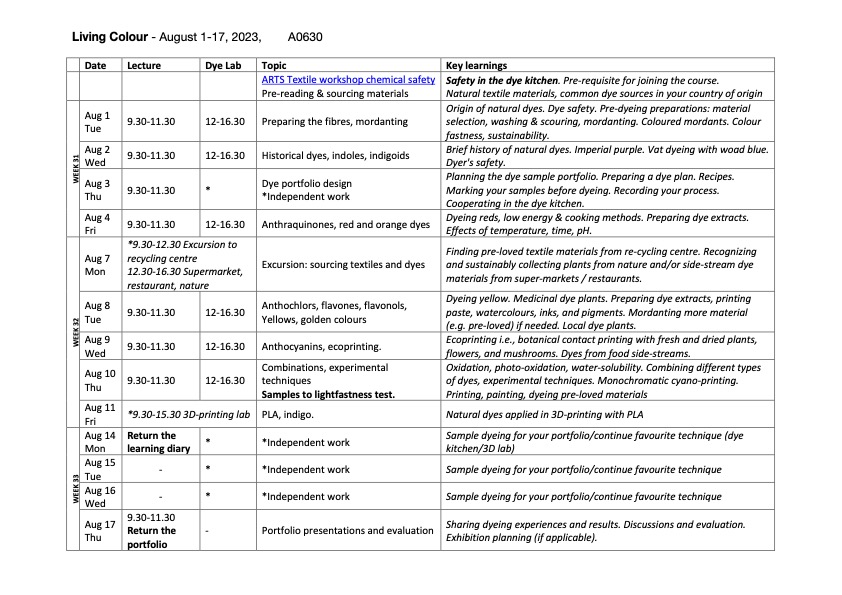

LEARNING OUTCOMES
Will be defined under each course seaparately.
The General Studies Courses with Varying Contents are courses, where themes, workin methods and teachers vary yearly. The courses try to react quickly to phenomenoms in the society today and in the art world, and therefore their focus lies differently than the more established courses. More detailed course descriptions will be given under each course.
Credits: 9
Schedule: 01.08.2023 - 17.08.2023
Teacher in charge (valid for whole curriculum period):
Teacher in charge (applies in this implementation): Paula Hohti, Kirsi Mantua-Kommonen, Eeva Heikkinen
Contact information for the course (applies in this implementation):
Responsible teacher: Paula Hohti
Course instructor: Kirsi Mantua-Kommonen
kirsi.mantua-kommonen@aalto.fi
tel. +358 50 434 7702
Office: Väre Building F201, Department of Art and Media, Aalto University, Otaniementie 14, 02150 Espoo, Finland
CEFR level (valid for whole curriculum period):
Language of instruction and studies (applies in this implementation):
Teaching language: English. Languages of study attainment: Finnish, Swedish, English
CONTENT, ASSESSMENT AND WORKLOAD
Content
valid for whole curriculum period:
Varies depending on the course. Will be defined under each course seaparately.
applies in this implementation
This multidisciplinary course approaches natural dyes and dyeing combining the perspectives of the participating students.
The course introduces several perspectives to natural dyes including
(i) sources for natural dyes (plants, fungi, invertebrates) and the colours available from them,
(ii) the chemical classes of natural dyes (e.g. indoles, anthraquinones, flavonols, anthocyanins),
(iii) the role of mordants (metal salts, tannins, acids, chitosan) and assists (alkaline/acid) in fixing and toning the colours achievable,
(iv) colourfastness concerning light, washing, rubbing,
(v) the differences between the natural dye processes for cellulosic and protein based materials, yarns, fabrics, and pre-loved textiles,
(vi) suitable dyeing and printing techniques for particular types of natural dyes, (vii) the functional potential of certain types of natural dyes,
(viii) artisan and industrial approaches to dyeing.
Learning is based on hands-on experimenting with natural dyes in lab setting creating a learning diary and a personal dye-sample portfolio with detailed information on the dyes, materials and processes, applicable for the student’s future work. We will work with various materials, yarn, fabric, fibre, felt (undyed cotton/linen/wool/silk/polyamide), pre-loved textiles (undyed cotton/linen/wool/silk/polyamide), PLA (3D-printing). Natural dyes extracted from plants, fungi, algae and invertebrates.
Assessment Methods and Criteria
valid for whole curriculum period:
Varies depending on the course. Will be defined under each course seaparately.
applies in this implementation
General, 1–5
Learning diary 20% (min. ½ x A4-pages/topic, 4–8 pages total) = 0–1.
Dye-sample portfolio 80% (samples from 8 dye labs, half point for each) = 0–4.
Minimum attendance to lectures and instructed dye labs: 80 %.
Workload
valid for whole curriculum period:
Varies depending on the course. Will be defined under each course seaparately.
applies in this implementation
Contact hours
Lectures 18 hours
Colour kitchen & 3D lab/group work 27 hours
Field excursion to recycling centre (voluntary), nature & supermarket 6 hours
Independent work:
Readings & learning diary 16 hours
Portfolio 16 hours
Additional dye lab (voluntary).
DETAILS
Study Material
applies in this implementation
Selected chapters from the following books:
Boutrup, J., Ellis, C. (2019): The Art and Science of Natural Dyes: Principles, Experiments, and Results. Schiffer publishing. 176 pages.
Cardon, D. (2007). Natural dyes. Sources, tradition, technology and science, Archetype. 778 pages.
Duerr, S. (2020). Natural palettes: inspiration from plant-based color. Princeton Architectural Press. 368 pages.Räisänen, R., Primetta, A., & Niinimäki, K. (2016). Dyes from nature. Archetype Publications. 290 pages.Räisänen, R., Primetta, A., & Niinimäki, K. (2015). Luonnonväriaineet. Maahenki. E-kirja (pdf) https://helda.helsinki.fi/handle/10138/316980Vankar, Padma Shree Shukla, Dhara. (2019). New Trends in Natural Dyes for Textiles. Elsevier. Retrieved fromhttps://app.knovel.com/hotlink/toc/id:kpNTNDT002/new-trends-in-natural/new-trends-in-natural
Additional reading: Articles specified for each topic/approach.
Substitutes for Courses
valid for whole curriculum period:
Prerequisites
valid for whole curriculum period:
FURTHER INFORMATION
Further Information
valid for whole curriculum period:
Teaching Language : English
Teaching Period : 2022-2023 Autumn I - Summer
2023-2024 Autumn I - SummerEnrollment :
Registration for courses: Sisu. Priority order to courses is according to the order of priority decided by the Academic committee for School of Arts, Design and Architecture, https://www.aalto.fi/en/services/registering-to-courses-and-the-order-of-priority-at-aalto-arts
Minimum amount of participants: see implementation. Maximum amount of participants: see implementation.
applies in this implementation
Pre-requisite for joining the lab work
Online safety course needs to be passed before starting the course. It takes about 45-60 minutes, and can be found here: ARTS Textile workshop chemical safety
